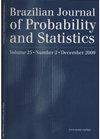一类新的右截和治愈分数存在下的二元Sushila分布
IF 0.5
4区 数学
Q4 STATISTICS & PROBABILITY
引用次数: 0
摘要
。本研究在Sushila分布的基础上引入了一种新的二元分布来对存在固定分数、右截尾数据和协变量的二元寿命数据进行建模。新的二元概率分布是用基于致命冲击的可靠性理论的方法得到的,这种方法通常用于建立新的二元模型。此外,根据广泛用于单变量寿命情况的标准混合模型的推广,在模型中引入了治愈率。利用MCMC(马尔可夫链蒙特卡罗)模拟方法生成模型所有参数的联合后验分布样本,在贝叶斯方法下获得模型参数的感兴趣推论。为了研究新方法的推理特性,进行了仿真研究。该方法还被用于分析一项回顾性队列研究中获得的一组真实医疗数据,该研究旨在评估影响糖尿病视网膜病变患者生活的特定临床条件。为了将所提出的模型与双变量生存数据分析中使用的其他常用模型区分开来,我们使用了一些贝叶斯模型区分技术,并从通常的Cox-Snell残差中验证了模型的有效性,这使我们能够确定所提出的双变量治愈率模型的充分性。本文章由计算机程序翻译,如有差异,请以英文原文为准。
A new class of bivariate Sushila distributions in presence of right-censored and cure fraction
. The present study introduces a new bivariate distribution based on the Sushila distribution to model bivariate lifetime data in presence of a cure fraction, right- censored data and covariates. The new bivariate probability distribution was obtained using a methodology used in the reliability theory based on fatal shocks, usually used to build new bivariate models. Additionally, the cure rate was introduced in the model based on a generalization of standard mixture models extensively used for the univariate lifetime case. The inferences of interest for the model parameters are obtained under a Bayesian approach using MCMC (Markov Chain Monte Carlo) simulation methods to generate samples of the joint posterior distribution for all parameters of the model. A simulation study was developed to study the inferential properties of the new methodology.The proposed methodology also was applied to analyze a set of real medical data obtained from a retrospective cohort study that aimed to assess specific clinical conditions that affect the lives of patients with diabetic retinopathy. For the discrimination of the proposed model with other usual models used in the analysis of bivariate survival data, some Bayesian techniques of model discrimination were used and the model validation was verified from usual Cox-Snell residuals, which allowed us to identify the adequacy of the proposed bivariate cure rate model.
求助全文
通过发布文献求助,成功后即可免费获取论文全文。
去求助
来源期刊

Brazilian Journal of Probability and Statistics
STATISTICS & PROBABILITY-
CiteScore
1.60
自引率
10.00%
发文量
30
审稿时长
>12 weeks
期刊介绍:
The Brazilian Journal of Probability and Statistics aims to publish high quality research papers in applied probability, applied statistics, computational statistics, mathematical statistics, probability theory and stochastic processes.
More specifically, the following types of contributions will be considered:
(i) Original articles dealing with methodological developments, comparison of competing techniques or their computational aspects.
(ii) Original articles developing theoretical results.
(iii) Articles that contain novel applications of existing methodologies to practical problems. For these papers the focus is in the importance and originality of the applied problem, as well as, applications of the best available methodologies to solve it.
(iv) Survey articles containing a thorough coverage of topics of broad interest to probability and statistics. The journal will occasionally publish book reviews, invited papers and essays on the teaching of statistics.
 求助内容:
求助内容: 应助结果提醒方式:
应助结果提醒方式:


